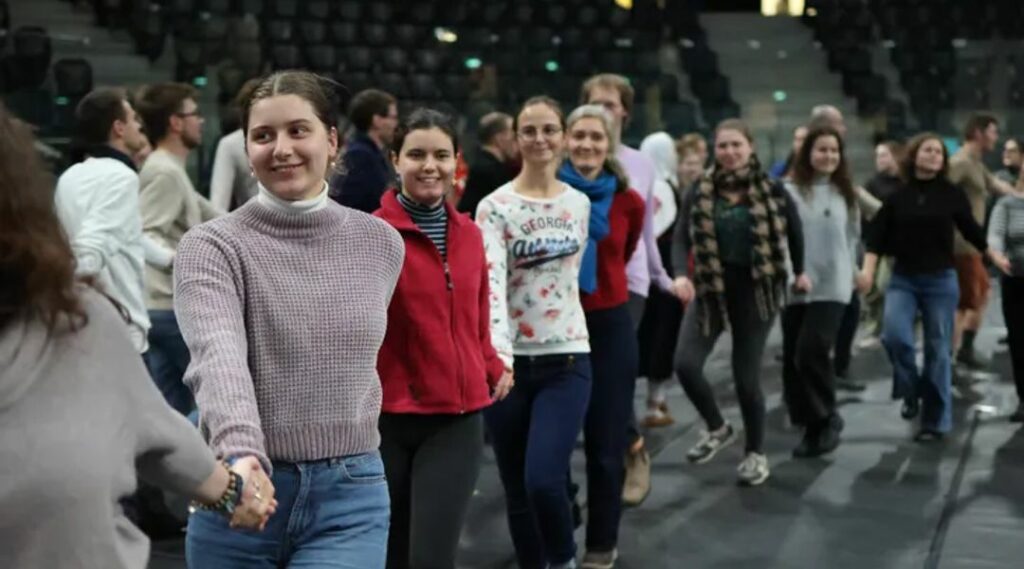Dressed in their vyshyvanka, the traditional embroidered Ukrainian blouse, Sofia, 18, and her brother Bogdan, 16, share their story. Their world crumbled during the Russian invasion on the night of February 23-24, 2022, when the first explosions forced them to flee Kherson in southern Ukraine for Ternopil in the west, where their grandmother lives.
“There are thousands of stories like ours,” Sofia told an audience of young Europeans packed into Tallinn’s small Ukrainian Greek Catholic church. “I came to Estonia to help young people from other European countries understand our situation,” she explains.
Hearing these stories was what drew Mathieu, 22, to Estonia for the 47th European Taizé Meeting. “The war in Ukraine has dragged on for three years, so in Western Europe, we think about it less,” he admitted. For him, the choice of Tallinn as the meeting’s location was a “turning point.” “I could have waited for a closer destination, but praying for peace and hope in a country bordering a conflict like Estonia gave this gathering much deeper meaning.”
Young people directly affected by war in Ukraine
Choosing this Baltic Sea country, which shares nearly 300 kilometers of border with Russia, was no coincidence for the Taizé brothers. Estonia’s collective memory still bears the scars of 20th-century Soviet occupation. The war in Ukraine, launched by Russian President Vladimir Putin in February 2022, rekindled tensions with the Russian-speaking communities that make up 30% of Estonia’s population.
“I grew up knowing that our independence was fragile and that, if Putin wanted to, he could conquer Estonia in a day,” said Natalia, a 23-year-old Estonian student. After nearly three years of war, she wonders if her country might be “next.” She took a gap year to help organize the European Taizé Meeting, which holds particular significance for her.
“We are a small country, and no one knows our story,” she sighed. “This gathering is an opportunity to show that our country, culture, and identity exist. It also allows us Estonians to feel that we are truly part of a European whole.”
Michalina, a 26-year-old Polish participant, also experienced the conflict “daily.” She is relieved that the gathering focuses on peace. Her time in Estonia gave her new perspectives: “I stayed in a large building that once housed Ukrainian refugees. Imagining myself in their shoes was deeply moving.”
In Poland, refugees often remain on the fringes of society. “I never interact with Ukrainians back home. Here, I heard their stories,” she said with appreciation. Estonia hosted nearly 60,500 Ukrainian refugees, a significant number for its population of 1.3 million. “Being here, we realize that we are not alone in facing the challenges of welcoming refugees,” she observes.
Bringing young people together
Uniting European youth to pray and reflect on shared themes is the hallmark of Taizé gatherings. Each day, participants engage in small-group discussions with individuals from different nationalities. In the afternoons, they attend thematic workshops and join evening prayers, which conclude with a meditation by Brother Matthew, the community’s prior.
“It’s very enriching to meet young people from across Europe and realize that we share the same personal struggles, though we see them from different perspectives,” says Natalia.
As a 29-year-old Belarusian participant, Natalia never missed Taizé gatherings or World Youth Day events in Europe. However, she almost missed Tallinn. Estonia fears Russian interference, and obtaining visas for Belarusians is cumbersome, if not impossible,” explained Brother Luc, a French organizer. Thanks to strong ties with the French Ministry of Foreign Affairs, the Taizé brothers facilitated visas for Belarusian pilgrims.
“For those living under authoritarian regimes, these gatherings are vital; they breathe life into them,” said Brother Luc. The same applies to the 20 Ukrainian Greek Catholic seminarians from Lviv, who, as young men eligible for conscription, are rarely allowed to leave Ukraine.
“Gathering despite geopolitical crises”
“We overcame many bureaucratic hurdles to attend,” confirmed Liubomyr, one of the seminarians. Although they constantly bear “the weight of the war on their shoulders,” coming to Tallinn allowed them to share their experiences from Ukraine, find solace in prayer, and connect with other cultures. “I was deeply inspired by the organization of Lutheran churches and their approach to making the Bible accessible,” said Nazan, another seminarian.
“Bringing young people together despite geopolitical crises has always been a priority for the community,” explained Brother Luc. He recalled Taizé brothers and young Eastern Europeans visiting during the 1970s-80s to build bridges despite the Iron Curtain. “Similarly, we must maintain contact with young Russians and Belarusians, if only to prepare for the future.”
Unfortunately, no visas were granted for the Russian youths eager to attend. “There are nearly 200 of them in Saint Petersburg, just 400 kilometers from Tallinn, who long for peace,” insisted Brother Luc.
While supporting them publicly is currently “unheard,” Brother Matthew stressed, “we cannot forget them.” On January 2, as participants head home, the Taizé brothers and a few volunteers will quietly travel to Narva, Estonia’s northeastern border town. There, “alongside our Christian brothers across the border, we will pray for peace.”
From Tallinn to Paris
The 47th European Taizé Meeting brought together over 3,500 young Christians from 45 nationalities under the theme “Hoping Against All Hope.”
Among them were 1,200 Poles, 450 Germans, 250 Ukrainians, 200 Croatians, and 150 French participants who traveled to the northernmost destination ever chosen by the community.
In a country where about 70% of the population identifies as agnostic, hosting pilgrims in local families, as is customary, posed a significant challenge for local churches.
The next meeting will take place in Paris from December 28, 2025, to January 1, 2026.
Source link : http://www.bing.com/news/apiclick.aspx?ref=FexRss&aid=&tid=677687dd396e4eb3957a469b841cc03a&url=https%3A%2F%2Finternational.la-croix.com%2Freligion%2Ftaize-gathering-in-estonia-praying-for-peace-at-the-edge-of-war&c=14713660273121204498&mkt=de-de
Author :
Publish date : 2025-01-02 03:00:00
Copyright for syndicated content belongs to the linked Source.
